Yogyakarta is a city in the province of DIY located in Java. Besides dubbed as a student city, Yogyakarta is also dubbed as a cultural city. This is because the city of Yogyakarta has a palace that is so thick with Javanese custom. In addition, in Yogyakarta also called the City of Students because many campuses or universities where studying in Yogyakarta. So, many students are traveling to Yogyakarta to continue their studies. Yogyakarta also has some popular foods that every person visit Yogyakarta might buy them to bring home.
1. Gudeg
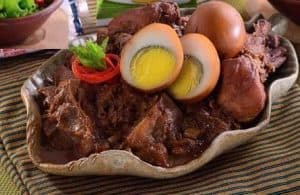 This food is made from young jackfruit. This is a typical culinary icon of Yogyakarta. The original flavor of gudeg is actually sweet. This is sometimes not suitable on the tongue of people outside Java.
This food is made from young jackfruit. This is a typical culinary icon of Yogyakarta. The original flavor of gudeg is actually sweet. This is sometimes not suitable on the tongue of people outside Java.
But the sweet taste of gudeg more delicious if eaten with rice, sambal goreng krecek, the chicken gravy and additional eggs, tofu, or tempeh bacem. There are two types of gudeg, namely wet and dry gudeg. The difference lies in the thickness of coconut milk gudeg, coconut milk dry gudeg more viscous than coconut milk gudeg.
2. Bakpia Pathuk
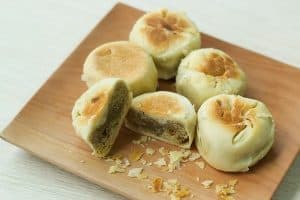 Bakpia is a food of green beans wrapped in flour. Over time, the contents bakpia not only green beans, now many variants of taste, such as chocolate, cheese, durian, to cappuccino and abon cow. Bakpia is one of the popular Jogja culinary icons.
Bakpia is a food of green beans wrapped in flour. Over time, the contents bakpia not only green beans, now many variants of taste, such as chocolate, cheese, durian, to cappuccino and abon cow. Bakpia is one of the popular Jogja culinary icons.
Some bakpia recommendations in Jogja are Bakpia Kurnia Sari, Bakpia Pathuk 25, Bakpia Pathuk 75, Bakpia Pia, and Bakpia Merlino. Bakpia prices range from Rp15.000 to Rp30.000.
3. Klathak satay
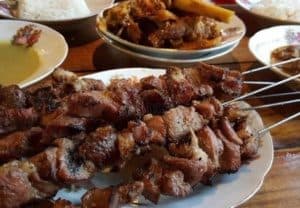 Sate klathak is the satay of goat which is only flavored salt and burned by using iron bars bike on charcoal. Iron bike puncture is what makes satay klathak becomes a unique and different satay. Iron bars serve to deliver heat to mature goats evenly.
Sate klathak is the satay of goat which is only flavored salt and burned by using iron bars bike on charcoal. Iron bike puncture is what makes satay klathak becomes a unique and different satay. Iron bars serve to deliver heat to mature goats evenly.
Sate klathak eaten with a serving of gule sauce. For lovers of goat meat, you should not miss this unique culinary. Some recommendation of satay klathak in Jogja is Sate Klathak Pak Pong, Sate Klathak Pasar Jejeran, and Sate Klathak Pak JeDe. The price of satay klathak ranges from Rp 12.000 to Rp 30.000.
Read also:
- Traditional Food Of Minang Kabau
- Traditional Food in Papua Indonesia
- Traditional Food in Bali Indonesia
4. Oseng-oseng Mercon
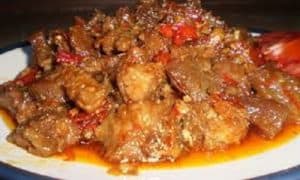 Oseng-oseng mercon is a food made of gravel, beef, and cayenne very much. The name of the mercon (fire crack) comes from the spicy bursts of cayenne pepper when chewed and the facial expression after eating the oseng-oseng, it feels like a bomb that explodes in the mouth.
Oseng-oseng mercon is a food made of gravel, beef, and cayenne very much. The name of the mercon (fire crack) comes from the spicy bursts of cayenne pepper when chewed and the facial expression after eating the oseng-oseng, it feels like a bomb that explodes in the mouth.
The famous Oseng-oseng mercon in Jogja is Oseng-oseng Mercon Bu Narti and oseng-oseng mercon located on Jl, K.H. Ahmad Dahlan. The price of oseng-oseng mercon ranges from Rp10.000 to Rp15.000.
5. Bakmi Goreng Jawa
 Basically, Bakmi is the food with a serving of noodles. Bakmi served with a mixture of meat or chicken and vegetables such as cabbage. This can be eaten with sauce or without sauce alias fried noodles.
Basically, Bakmi is the food with a serving of noodles. Bakmi served with a mixture of meat or chicken and vegetables such as cabbage. This can be eaten with sauce or without sauce alias fried noodles.
Formerly, noodles were brought by Chinese merchants to Indonesia, then Bakmi adapt to Indonesian spices. Some of the famous Bakmi Goreng Jawa recommendations are Bakmi Kadin, Bakmi Mbah Mo, Bakmi Mbah Gito, Bakmi Jombor, and Bakmi Pele. The price of noodles is around Rp15.000, – an.
6. Sego Kucing
 Sego kucing, or in English could be said as cat rice, is the rice wrapped in banana leaf with a mixture of anchovy, chilli, or tempeh at the top. It is called a sego kucing because this rice is made in small portions, just a few times a mouthful, like the portion of a cat. Sego kucing is the main menu in angkringan.
Sego kucing, or in English could be said as cat rice, is the rice wrapped in banana leaf with a mixture of anchovy, chilli, or tempeh at the top. It is called a sego kucing because this rice is made in small portions, just a few times a mouthful, like the portion of a cat. Sego kucing is the main menu in angkringan.
For Yogya students, eating in angkringan is the best way to save money. Some popular angkringan recommendations among Yogyakarta students are Angkringan Lek Man, Angkringan KR, Angkringan Bonbin, Angkringan Nganggo Suwe, and Angkringan Pendopo Ndalem. Sego Kucing price ranges from Rp1.000 to Rp3.000.
7. Yangko
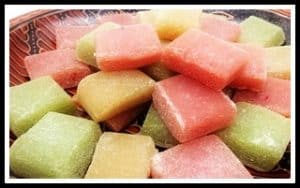 Yangko is a food originated from Yogyakarta city that made of sticky rice flour. Yangko box-shaped with glutinous rice flour, chewy, and sweet taste. In its original taste, Yangko contains a mixture of peanuts, like Japanese moci cakes. Only difference, moci more soft and more chewy than yangko. In addition to the original taste, now yangko also has a taste of fruits, such as strawberries, durian, and melon. Yangko is commonly found in Kotagede, Yogyakarta.
Yangko is a food originated from Yogyakarta city that made of sticky rice flour. Yangko box-shaped with glutinous rice flour, chewy, and sweet taste. In its original taste, Yangko contains a mixture of peanuts, like Japanese moci cakes. Only difference, moci more soft and more chewy than yangko. In addition to the original taste, now yangko also has a taste of fruits, such as strawberries, durian, and melon. Yangko is commonly found in Kotagede, Yogyakarta.
Read also:
8. Geplak
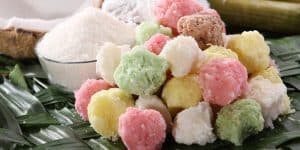 Geplak is a kind of food from the city of Bantul which is quite famous for the tourists who visit Yogyakarta. Geplak shaped spheres of coconut meat served with a sweet taste.
Geplak is a kind of food from the city of Bantul which is quite famous for the tourists who visit Yogyakarta. Geplak shaped spheres of coconut meat served with a sweet taste.
Initially geplak which is a culinary rich taste this sweetness only has white and dark colors, but along with the development of the times, Geplak processed began to be modified with color and aroma of a variety so more interesting buyers to taste it.
9. Geblek
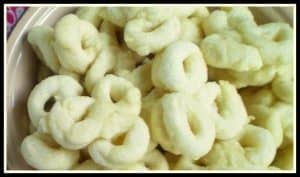 This is a snack from Kulonprogo Regency, west side of Yogyakarta. Geblek made from tapioca flour spiced with garlic. The color is white and the texture is chewy like cireng. When it is fried, the outside becomes crisp, but the inside is still soft.
This is a snack from Kulonprogo Regency, west side of Yogyakarta. Geblek made from tapioca flour spiced with garlic. The color is white and the texture is chewy like cireng. When it is fried, the outside becomes crisp, but the inside is still soft.
To add to its flavor, geblek can be enjoyed with a splash of peanut sauce. This snack is suitable to be made by typical souvenir from Jogja, besides bakpia or gudeg. Buy a geblek that has not been fried, then you can fry it yourself when he got home.
10. Tiwul
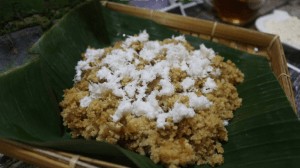 The main dish on tiwul is cassava that has been dried to dry or commonly called cassava. Cassava then finely ground and steamed until cooked. In the past, tiwul had become the staple food of the community due to the price of rice that is too expensive so that can not be bought by the community.
The main dish on tiwul is cassava that has been dried to dry or commonly called cassava. Cassava then finely ground and steamed until cooked. In the past, tiwul had become the staple food of the community due to the price of rice that is too expensive so that can not be bought by the community.
Therefore, to meet the needs of the stomach, Indonesians of especially in the area of Yogyakarta replaced rice with tiwul that eaten with side dishes and vegetables.
11. Kipo
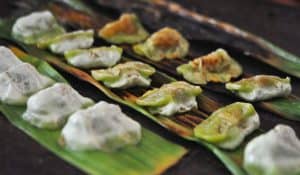 Kipo is a food made from sticky rice, shaped small, filled with sugar coconut dough, green with the contents of grated coconut mixed with small Javanese sugar as big as thumb wrapped or placed on a banana leaf and then baked.
Kipo is a food made from sticky rice, shaped small, filled with sugar coconut dough, green with the contents of grated coconut mixed with small Javanese sugar as big as thumb wrapped or placed on a banana leaf and then baked.
The process of making kipo is very simple.
How and the manufacture is still natural and not derived from processed materials. Taste and aroma is unique and unique shape makes kipo sought by people around Kotagede. It is v
12. Jadah Tempe
 Jadah which is a traditional food from Sleman regency, precisely derived from the slope of Mount Merapi, Kaliurang. It is actually a combination of two types of traditional Javanese food namely jadah which is processed food from ketan (sticky rice) and tempe.
Jadah which is a traditional food from Sleman regency, precisely derived from the slope of Mount Merapi, Kaliurang. It is actually a combination of two types of traditional Javanese food namely jadah which is processed food from ketan (sticky rice) and tempe.
Tempe will usually be processed by cooked with palm sugar and some of Javanese seasoning. Jadah which is a food made from sticky rice is usually in a mixture of grated coconut that raises a savory taste in the tongue.
13. Sate Kuda
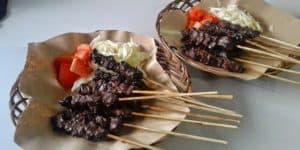 Usually, satay or sate is made from mutton, beef, or chicken. But in Yogyakarta you can taste different food, which is famous sate kuda with the delicious taste. Sate Meat horse in addition to having a delicious and delicious horse meat is believed as a medicine of various diseases, such as rheumatism, asthma, and can increase the passion of the men.
Usually, satay or sate is made from mutton, beef, or chicken. But in Yogyakarta you can taste different food, which is famous sate kuda with the delicious taste. Sate Meat horse in addition to having a delicious and delicious horse meat is believed as a medicine of various diseases, such as rheumatism, asthma, and can increase the passion of the men.
The sate kuda sellers in Jogjakarta quite a lot, among them on Jl. Kranggan, in the area of Pojok Beteng Wetan, at Jalan Jendral Sudirman, to Jalan Parangtritis. Horse meat made in sate usually obtained from horse slaughtering place in Pleret Bantul area.
Those are some goods that popular in Yogyakarta. Almost of the taste cuisines in Java are sweet. Make sure you like that taste if you go to Yogyakarta.
Read also:
- Street Food in Kuta
- Street Foods in Seminyak Bali
- Yogyakarta Traditional Foods
- Healthy Foods in Yogyakarta
